The 1920s was an era where women were prized by the handbags, purses, and shopping bag styles that they wore. Attention was given to women who were well-dressed and exuded a sense of professionalism. Women were typically identified based on their choice of clothing: it was a sense of pride and identity. A peek inside a woman’s bag today, however, you can find: cell phone, car keys, wallet, make-up, and a whole other range of things that are all essential items for a part of a woman’s day. During the roaring twenties, 1920’s handbags, purses, and shopping bags held very little in them. Not only are they impractical, but also not versatile for everyday usage.
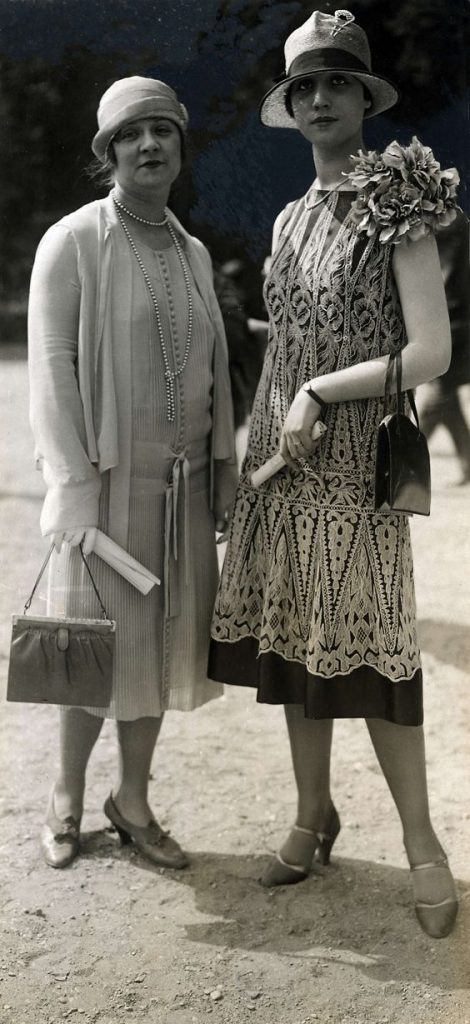
Handbags were tiny in size. They did not hold much – it was just a bag that was simply for the purpose of accessorizing one’s outfit. During the whole decade, there was no introduction of different styles of bags (tote bags, backpacks, anything with a shoulder strap). A glance in a woman’s bag would’ve illustrated just some lipstick, house-key, and other portable items that were small and valuable. That’s it!
Later, extensive collections of bags came to life. At the time, bags and purses were available but they were not quite as popular. The best mixture of materials in the contemporary past was made out of long-lasting touch in terms of the incorporation of materials and styles.
If it wasn’t for the increase in demand for cigarettes and using make-up, there would be no need to carry purses at all. Handbags were for the sole purpose of fashion rather than function. It was not even tailored for the function of practicality, but to enhance a sense of fashion.
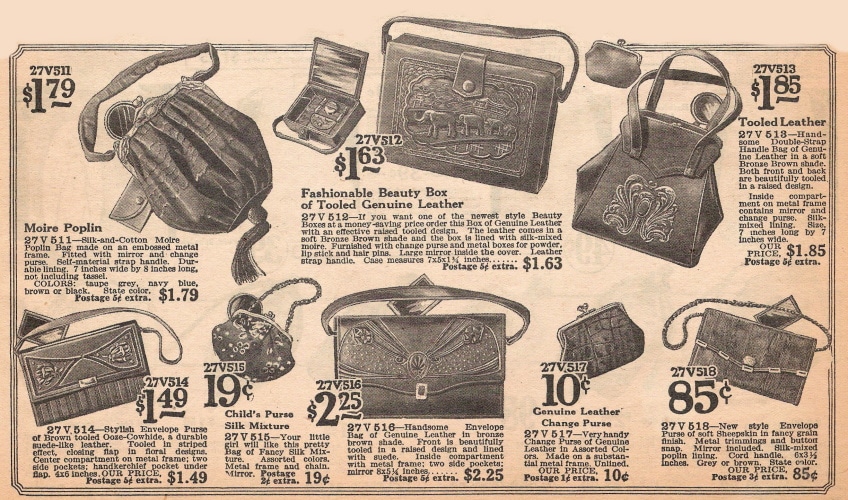
TYPES OF 1920S HANDBAGS – DAYTIME
Daytime purses were carried by women every day. As mentioned above, if it wasn’t for the increase in demand for cigarettes and using make-up, there would be no need to carry purses at all.
Handbags were for the sole purpose of fashion rather than function. It was not even tailored for the function of practicality, but to enhance a sense of fashion. It was small and made out of leather or fabric.
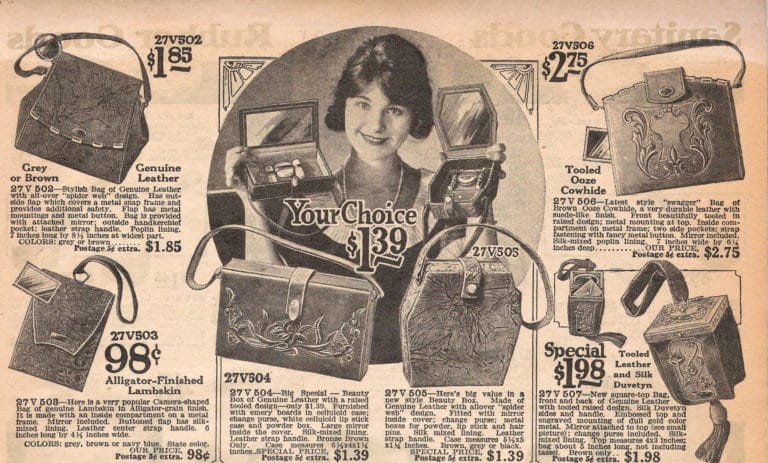
Colors were simple – they lacked pattern or expression in the bags itself. By the end of the roaring twenties, the colors of bags and purses expanded to different colors. They expanded into new pastel shades such as purple, cream, light green, yellow, pink, and other colors. Due to the increase in choices, women were allowed to involve themselves in more shades and tones – a happier society!
These bags were typically flat with a frame top and locking mechanism (twist knob, kiss lock, snap lock, zipper, or slide lock).
- Pochettes, underarm bags, and clutch bags were names given to a new-ish style of the small handbag in the roaring twenties. Pochettes were bags that were rectangular in shape – similar to envelop bags. It was usually small enough to be tucked under the arm or worn with a vertical strap on the backside. Additionally, it could be worn in different patterns and styles. There was an extensive range of patterns and textures. Interestingly, animal skin also became popular starting in the mid-1920s- lizard, alligator, crocodile, and snakeskin.
- The clutch purse was so popular it stayed that way for decades.
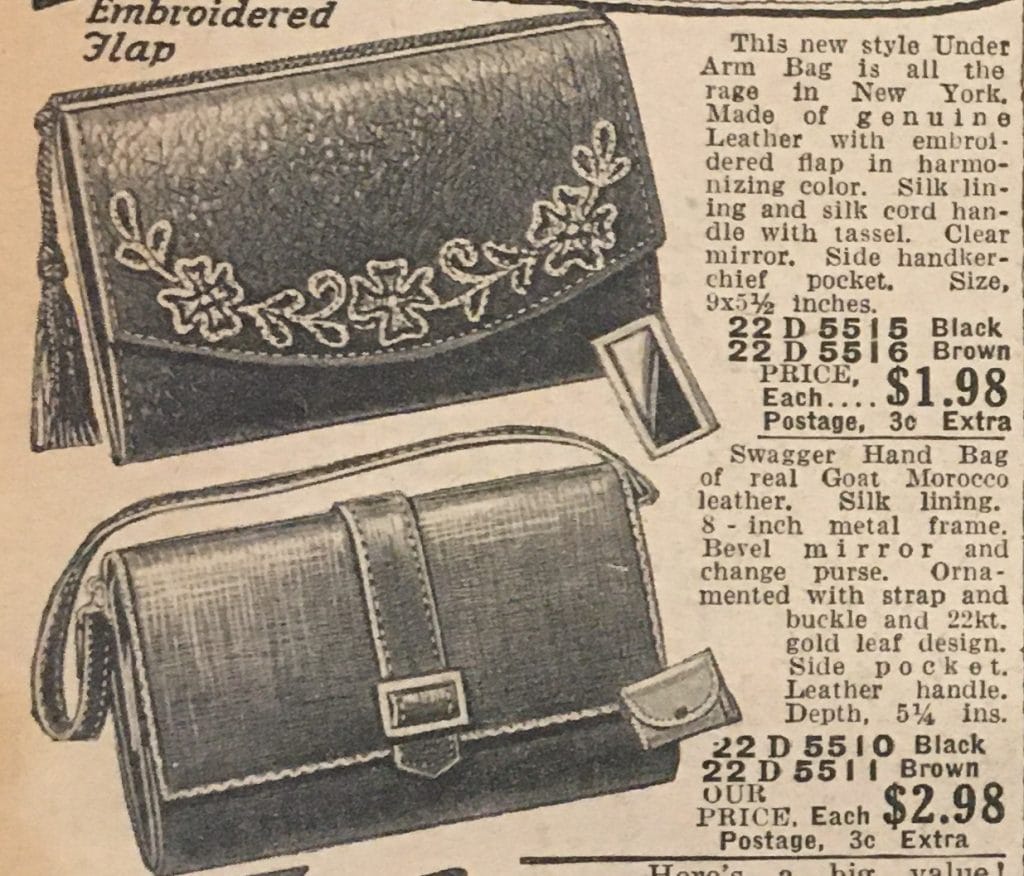
Clutch purses were typically worn by women who were fond of attending evening occasions and general festivals. Those who wanted to elevate their sense of fashion wore matching gloves with the clutched purses. The roaring twenties also presented an era where vintage gloves stayed. After the war, women still continued to wear these gloves.
We witnessed a complete transformation of gloves – from having to wear it every day to now, not at all. Vintage gloves, however, stayed very plain as seen in the 1900s-1910s. As mentioned previously during the 1910s, popular colors were tan, brown, black, white, red, green. These colors were picked based on the need to compliment her other pieces of clothing. Hence, depending on her other pieces of clothing, the color of her gloves will be chosen.
Clutches were made from non-leather materials as well as made with leather.
Many people were not fond of the idea of carrying another item other than their phone or wallet. They wanted to travel freely and lightly. It wasn’t pleasing to think about carrying another item such as a bag. It is established that Coco Chanel often took her designs from menswear – she was not fond of carrying bags or purses. She did not like the idea of having to carry either clutch purses or pochettes. She finally added straps to her handbags – introducing a style of both practicality and style.
Cloth Bags
Reticules were small pouches with drawstrings. Women usually carried it around to hold either their coins or a small cell phone. They remained in style during the early twenties but quickly went out of style as more popular and trendy purses and bags that were more versatile and practical were introduced.
They were made out of different fabric materials. Namely, velvet, silk, satin, cotton, or even canvas. Women tended to decorate their cloth bags based on the designs that they liked. Embroidery was an important style of fashion that was readily available as most women stayed at home and did not involve themselves in other activities. They had the option to spend more time on decorating their possessions. They usually made prints that matched with their everyday pieces of clothing to make sure that everything went well! Other crafty women purchased purse kits, which included the materials, beads, and frames to make a purse at home. Knitting bags was yet another homemade purse option.
Evening Bags
- Evening Bags was the epitome of bags from the roaring twenties. They were authentic and displayed the style and trend during the famous twenties!
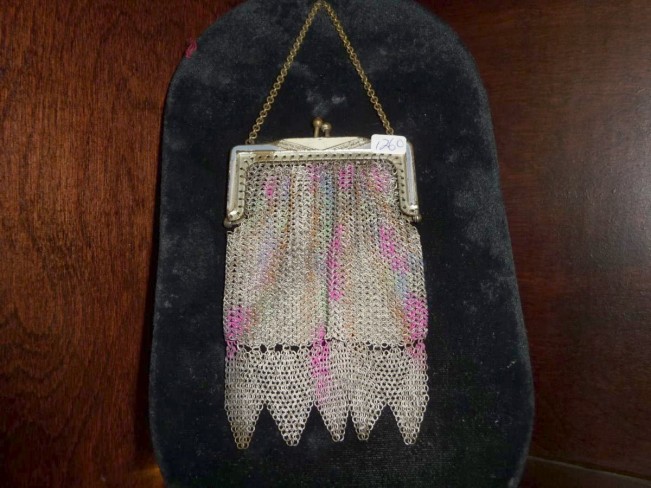
While reticules were small pouches with drawstrings. Women usually carried it around to hold either their coins or a small cell phone. They remained in style during the early twenties but quickly went out of style as more popular and trendy purses and bags that were more versatile and practical were introduced.
Evening bags quickly became the stars of the 1920s as they incorporated more fancy and decorative prints! Designs were pulled from all of the art movements and global influences.
- Mesh bags were usually longer and more slender in style. Bags made from metal mesh went back decades but found a new popularity in the ’20s.
Shopping bags and carts
A small handbag was not useful for when a woman had to do her own groceries for shopping. As most women were involved in running errands, they were the ones shopping for groceries during the roaring twenties.
They needed larger bags that would fit the groceries that they bought – a strap or handle was needed as well.
When a woman completed her housework chores and was done with her professional work, she is typically the one in the household who conducted errands around town. While men were told to work and earn money, women were the ones taking care of the house and running errands. Clothing was kept simple but the quality of clothing was of higher quality than cotton house dresses. They wore either dress paired with a pair of mid-heel Oxfords, Mary Jane, or T-Strap shoes, which is most common in the daytime fashion. They would then pair it with their shopping bags and carts.
- A woven straw shopping basket remained popular for women, especially in Europe. For groceries, many stores provided great delivery services. For women in town, shopping carts would have been utilized over heavy leather bags that lacked practicality.
1920s reproduction bag
Only a few designers tried to revive the bags from the roaring twenties.
- Whiting and Davis (1896) were the first producers of metal mesh bags.
Until this day, they continue to produce new mesh bags with different patterns and prints that are associated with this era! They were both practical and fashionable. I still come across these bags from the vintage stores.
- Mary France
She reproduces several bags from the 1920s. Most of her designs are just inspired by the designs from the roaring twenties – she also utilizes lots of patterns and prints that represented the roaring twenties era. Additionally, it could be worn in different patterns and styles. There was an extensive range of patterns and textures. Interestingly, animal skin also became popular starting in the mid-1920s- lizard, alligator, crocodile, and snakeskin.
Conclusion

We have discussed that the roaring twenties was an era where women were prized by the handbags, purses, and shopping bag styles that they wore. Attention was given to women who were well-dressed and exuded a sense of professionalism. Women were typically identified based on their choice of clothing: it was a sense of pride and identity. A peek inside a woman’s bag today, however, you can find: cell phone, car keys, wallet, make-up, and a whole other range of things that are all essential items for a part of a woman’s day. During the roaring twenties, 1920’s handbags, purses, and shopping bags held very little in them. Not only are they impractical, but also not versatile for everyday usage.
We have also discussed that if it wasn’t for the increase in demand for cigarettes and using make-up, there would be no need to carry purses at all. Handbags were for the sole purpose of fashion rather than function. It was not even tailored for the function of practicality, but to enhance a sense of fashion. Daytime purses were carried by women every day for the sole purpose of fashion. As mentioned above, if it wasn’t for the increase in demand for cigarettes and using make-up, there would be no need to carry purses at all.
We have discussed different types of bags:
- Pochettes, underarm bags, and clutch bags were names given to a new-ish style of the small handbag in the roaring twenties.
- Reticules were small pouches with drawstrings. Women usually carried it around to hold either their coins or a small cell phone. They remained in style during the early twenties but quickly went out of style as more popular and trendy purses and bags that were more versatile and practical were introduced.
- The clutch purse was so popular it stayed that way for decades.
- Mesh bags were usually longer and more slender in style. Bags made from metal mesh went back decades but found a new popularity in the ’20s.
- Evening Bags was the epitome of bags from the roaring twenties. They were authentic and displayed the style and trend during the famous twenties!
- A woven straw shopping basket remained popular for women, especially in Europe for groceries and running errands.
We have also explored how only a few designers tried to revive the bags from the roaring twenties:
- Whiting and Davis (1896) were the first producers of metal mesh bags.
Until this day, they continue to produce new mesh bags with different patterns and prints that are associated with this era! They were both practical and fashionable. I still come across these bags from the vintage stores.
- Mary France
She reproduces several bags from the 1920s. Most of her designs are just inspired by the designs from the roaring twenties – she also utilizes lots of patterns and prints that represented the roaring twenties era. Additionally, it could be worn in different patterns and styles. There was an extensive range of patterns and textures. Interestingly, animal skin also became popular starting in the mid-1920s- lizard, alligator, crocodile, and snakeskin.
As explored throughout the article, women were dressed in rather simplistic and formal nature during the 20s. 1920s women embraced their carefree and lively manner which is easily represented by their choice of clothing. As a result, this enabled them to pursue new identities and opened new doors for the rise of women’s rights. This opened many doors and opportunities for women in the 20s. The outfits worn by these women remain timeless despite the shift in societal changes and time.

